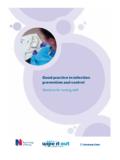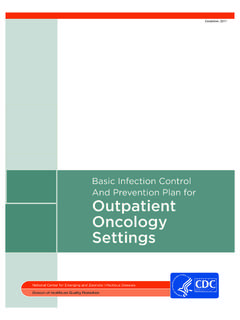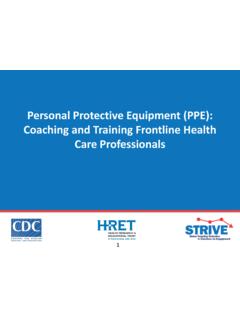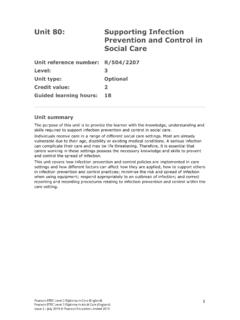Transcription of STANDARD OPERATING PROCEDURES (SOPS) for …
1 STANDARD OPERATING PROCEDURES (SOPS) for INFECTION CONTROL & PREVENTION (COVID -19) National Health Mission Dept. of Health & Family Welfare, Govt. of Assam 2 Table of Contents Sl. no. Topics Page no. 1. Introduction 3 - 4 Benefits of IPC Goals of IPC STANDARD precautions 2 . IPC Measures in A. Triage Area 4 B. Transport of Infectious Patients 4 - 6 Equipment Disinfection Decontamination of Ambulance Decontamination of Private Ambulance /Vehicle C. Isolation Ward/ICU 6 - 7 3.
2 Personal Protective Equipment Suggested PPE for management of COVID-19 PPE to be used in the OPD & IPD Sequence of Donning &Doffing of PPE 7 - 11 4. Disposal of COVID-19 waste 12 - 13 5. Environmental cleaning Cleaning of ICU/Isolation Ward Cleaning of Administrative Block/ Office areas/ Spaces Cleaning toilet 13 - 16 6. Linen and laundry management 16 7. Cleaning of kitchen environment 17 8. Disposal of dead body 17 - 18 9. Annexure 19 3 Corona Virus Disease 2019(COVID-19): STANDARD OPERATING Procedure (SOP) for Infection Control and BMW for COVID-1 INTRODUCTION : This SOP is applicable to current phase of COVID-19 Pandemic in India, where in as per plan of action, all suspect cases are admitted to isolation facilities.
3 These aims to guide the Health care providers /supportive programme officers/ to follow infection prevention & biomedical waste management protocols of the screening areas/ quarantine camps /transportation/ Isolation wards/ICU/ Laboratory . INFECTION CONTROL AND PREVENTION MEASURES BENEFITS OF IPC: A. Protecting yourself B. Protecting your patients C. Protecting your family, community & environment GOAL OF IPC: 1. To reduce transmission of health care associated infections 2. To enhance the safety of staff, patients and visitors 3. To enhance the ability of the organization/health facility to respond to an outbreak 4.
4 To lower or reduce the risk of the hospital (health care facility) itself amplifying the outbreak GENERAL ADVICE FOR COVID-19: 1. Avoid close contact with people suffering from acute respiratory infections . 2. Maintain distance of at least 1 meter from any individual . 3. Frequent hand hygiene, especially after direct contact with ill people or their environment. 4. Avoid touching your eyes, nose, or mouth with unhygienic hands. 5. People with symptoms of acute respiratory infection should practice Respiratory etiquette Wear a medical mask (Wear triple layer mask) Seek medical care for advice STANDARD PRECAUTION: HAND HYGIENE: Effective hand hygiene plays a very important role in infection prevention and control and in reducing the risk of infection in health care settings.
5 Hand Washing : Duration: min 40-60 Seconds Hand Sanitizer : Duration : 20-30 seconds 4 Types of Hand Hygiene : Hand washing with soap and water is the most frequent way of cleaning the hands in the hospital . Hand Sanitization is a quick and convenient and alternative to hand washing for already physically clean hands which are not visibly contaminated with dirt or organic material, especially when soap and water for hand washing is not readily available. Remember, Hand Hygiene is the most important and effective measure for COVID-19 Prevention.
6 My 5 Moments for Hand Hygiene relevant to COVID-19: 1. Before touching a patient, 2. Before clean/aseptic PROCEDURES , 3. after body fluid exposure/risk, 4. After touching a patient,. 5. After touching patient surroundings. Moments 1 & 4 relevant to COVID-19: Also include after shaking hand, sneezing or coughing, touching PPE, doffing of PPE. INFECTION PREVENTION CONTROL MEASURES : Screening /Triage area : The triage or screening area requires the following equipment: Screening questionnaire Hand hygiene equipment (sanitizer, water, soap and posters) Waste bins and access to cleaning /disinfection Triple layer mask Transport of Infectious Patients: Infected or colonized areas of the patient s body are covered: - - For contact isolation this may include a gown, sheets or dressings to surface wounds.
7 These patients are transferred to a STANDARD Pressure or Protective Environment Isolation room - For respiratory isolation the patient is dressed in a mask, gown and covered in sheets; these patients are accommodated in a Negative Pressure Isolation Room - For quarantine isolation the patient may be transported in a fully enclosed transport cell or isolator with a filtered air supply and exhaust; these patients are accommodated in a high level quarantine isolation suite. The transport personnel remove existing PPE, cleanse hands and transport the patient on a wheelchair, bed or trolley, applying clean PPE to transport the patients and when handling the patient at the destination.
8 A combination of nominated lifts, corridors and a bed transfer floor would assist in the movement of infectious patients through the hospital and minimize the risk of spread of infection 5 Equipment disinfection Use in Ambulance/Transpiration Equipment and surfaces are contaminated if they have come in contact with patient s skin, blood or body fluids. These can spread infection. Therefore, it is mandatory that these are cleaned and disinfected using 1% Bleaching Powder Solution ( Chlorine solution) or 1% sodium hypo chlorite or alcohol based disinfectants at least once daily and after every patient contact.
9 Patient care items and surfaces that can contribute to the spread of infection include: Stethoscopes Blood pressure cuff Monitors Stretchers ,backboards immobilization devices Laryngoscope blades Radios/mobiles Shelves Door handles Other items and surfaces in ambulance or transport vehicle Decontamination of ambulance : Decontamination of ambulance needs to be performed every time a suspect/confirmed case is transported in the ambulance. The following procedure must be followed while decontaminating the ambulance: Gloves and Triple Layer masks are recommended for sanitation staff cleaning the ambulance.
10 Disinfect (damp wipe) all horizontal, vertical and contact surfaces with a cotton cloth saturated (or microfiber) with a 1% sodium hypochlorite solution or 1% Bleaching Powder Solution ( Chlorine solution). These surfaces include, but are not limited to: stretcher, Bed rails, Infusion pumps, IV poles/Hanging IV poles, Monitor cables, telephone, Countertops, sharps container. Spot clean walls (when visually soiled) with disinfectant-detergent and windows with glass cleaner. Allow contact time of 30 minutes and allow air dry. Damp mop floor with 1% Bleaching Powder Solution ( Chlorine solution) or 1% sodium hypochlorite disinfectant.





